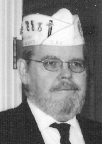 | Frank Bergquist graduated from Eddyville, IA, high school in 1958. After graduation, he entered the Army, serving 20 years in Missouri, Maryland, New Mexico, Germany, Iowa, Turkey, Kansas, S.E. Asia, and finally retiring in 1978 in Louisiana. Before retiring, Frank was assigned as an ROTC instructor at WSU and Kemper Military School until 1974. In 1978 he served as the Non-Commissioned officer in charge of operations at Fort Polk, LA. He has served as the Veterans Counselor (DVOP) with the Kansas Job Service Center National Service Office, with the Disabled American Veterans at the VA Regional Office in Wichita; Veterans Employment and Training Coordinator with the US Dept. of Labor at Ft. Riley, KS; Service Coordinator with Cerebral Palsy Research Foundation; Dept Adjutant-Treasurer and the Dept. Executive Director Dept. of Kansas Disabled American Veterans; and past President of the Wichita Civil War Round Table. Currently he is doing graduate work as an instructor in Genealogy and Military History at Wichita State and Kansas State Universities, and is the CEO for the Disabled American Veterans Thrift Stores in Wichita, KS. Bergquist has an AA from Kemper Military School and College from Boonville, MO. and a BGS from Wichita State University. He can be reached by telephone at 316-262-6501. He is located at 926 N. Mosley Wichita 67214. |
Veteran Affairs
2009-04-01 14:39:00
Who was Captain Kirk?
Answer: “WITH FLAG ON HIS BREAST” with the following statement as an explanation: “Captain Kirk Laid to rest by His Comrades Yesterday”. So read the Wichita Beacon on Thursday, August 1 of 1907 for former Captain Jonathan C. Kirk.
His funeral was held at his home, only in this case his home was the Baltimore Hotel. This was the home of Captain Kirk and also that of his son F.W. Kirk. His home was at 302 Pattie Avenue in Wichita. Both Grand Army of the Republic (GAR) members and their wives were present. The services at the home started with a singing of America. Rev. N.E. Harmon of the GAR, then delivered a touching sermon on the life of Captain Kirk.
After the services, the old soldiers who did not drive boarded a special street car and were taken to Maple Grove Cemetery. There they marched as a group to the GAR burial ground. Following interment, there was a short GAR service.
His Medal of Honor citation was somewhat short: “Volunteered for dangerous service and single-handedly captured 13 armed Confederate soldiers and marched them to the rear.” He was a Captain and a member of the Company F, 20th Indiana Infantry at the time. This action occurred at North Anna River, VA on May 23, 1864. He did not receive his Medal of Honor until June 13, 1894 over thirty years later. Most veterans did not know that they had received the MOH. They had to apply through the local GAR post and usually the medals were simply mailed to them. Captain Kirk entered the service in Wilmington, Ohio and was born in Clinton County, Ohio.
The brief notation about Captain Kirk does not tell us much about the man. Even the history of the unit, in this case the 20th Indiana Infantry does not say much. At Gettysburg, you cannot generally tell from the ornateness of a monument, whether the regiment was nearly slaughtered here or whether it simply sat in reserve. Such a case is the 20th Indiana: a very simple monument. The monument is located on the edge of the Wheatfield along Cross Avenue. This monument was dedicated on October 28, 1885. It was part of the 3rd Corps,1st Division, and 2nd Brigade
The regiment was raised from the counties of Cass, Lake, Laporte, Marion, Marshall, Miami, Porter, Tippecanoe, and White in the summer of 1861, the 20th was commanded at Gettysburg by Col. John Wheeler (1825-1863), an editor from Crown Point. The monument stands near where he was killed in 1863. Command then fell to Lt. Col. William C.L. Taylor (1836-1901), a lawyer from Lafayette. The 20th Regiment Infantry “Fighting Three Hundred” was his unit. It was 0rganized at Lafayette, Ind., and mustered in July 22, 1861. The unit left Indiana for Baltimore, Md., August 2. During their military service the regiment lost 15 Officers, and 186 Enlisted men were killed and mortally wounded, and 113 Enlisted men by disease. At the end of the war they were moved to Louisville, Ky., June 14-21 and duty there until July 12. Mustered out July 12, and discharged at Indianapolis, Ind.
But what of Captain Kirk? His MOH was awarded for his actions on May 23, 1864. That was the Battle of the North Anna River. Other than the brief statement, we know nothing more about his service. His military records make no mention of the award or action. Captain Kirk is buried by the GAR Memorial Pavilion in Maple Grove Cemetery in Wichita. His stone was replaced with the right marker for Medal of Honor recipient. Each Memorial Day and Veterans Day it is appropriately marked.


